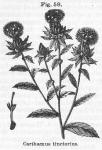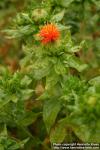
 Related entry: Crocus (U. S. P.)—Saffron
Related entry: Crocus (U. S. P.)—Saffron
The florets of Carthamus tinctorius, Linné.
Nat. Ord.—Compositae.
COMMON NAMES AND SYNONYM: Safflower, Bastard saffron, Dyer's saffron, African saffron, False saffron, American saffron; Flores carthami.
Botanical Source.—Carthamus tinctorius is an annual plant, with a smooth stem, growing from 1 to 2 feet high, striate, and branching at the top. The leaves are alternate, ovate-lanceolate, sessile, spinose-denticulate, subamplexicaul, smooth and shining. The flowers are numerous, long, slender, orange-colored, and borne in large, terminal, discoid heads. The florets are tubular; the corolla infundibuliform and 5-cleft (W.).
History and Description.—This plant is cultivated in this country and Europe, though inhabiting Egypt and the countries surrounding the Mediterranean Sea. The orange-red florets are the medicinal parts, and are generally met with in commerce in laminated masses, with the yellow filaments accompanying. Their odor is peculiar and aromatic, and the taste slightly bitter. Dyer's saffron is sometimes used to adulterate genuine saffron, but may be detected by the cannular form of the flowers, the reddish-yellow color of the stamens and pistils, and the absence of the white ends belonging to the true saffron. The cultivated safflower in this country is usually sold unpressed, as American saffron.
Chemical Composition.—Safflower contains 2 coloring matters: the first, which is soluble in water, is yellow (called Safflor yellow); the other has a beautiful red color, greenish in reflected light, is insoluble in water, fixed and volatile oils, ether, and in diluted acids, is slightly soluble in alcohol, but readily soluble in alkaline solutions, in which, however, it readily decomposes, with discharge of the color, and is termed carthamin, or carthamic acid (C14H16O7). Its acid properties are feeble. Dried and mixed with French chalk, it constitutes rouge, which is used as a cosmetic. Carthamin is the valuable dye constituent. Both carthamin and safflor yellow were investigated particularly by Schlieper. The former exists in small amount (0.3 to 0.6 per cent); the latter is abundant (25 to 30 per cent).
Action, Medical Uses, and Dosage.—Dyer's saffron, when the warm infusion is used, is said to restore the menstrual discharge which has been recently suppressed by cold; also when taken largely, to produce an action on the bowels. The warm infusion is often employed as a diaphoretic in domestic practice among children and infants in measles, scarlet fever, and other eruptive maladies. It may be given tolerably freely. The infusion may be made by infusing 1 or 2 drachms of the flowers in ½ pint of boiling water. The seeds are white and angular, and have been much used as a purgative and emmenagogue. They yield an oil by expression, which has been used as a local application in rheumatic and paralytic affections; also for bad ulcers.

